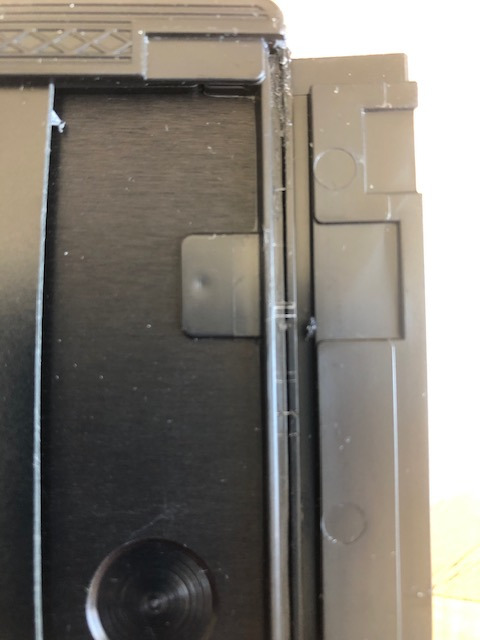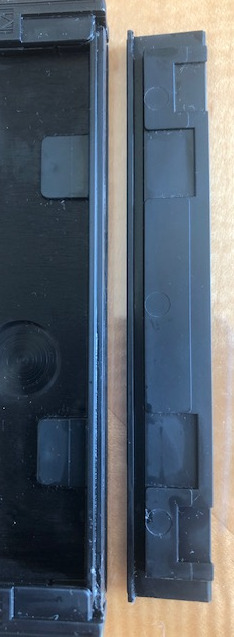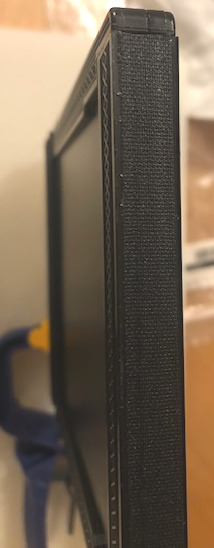Cameras
Replacing Film Holder Tape
These notes apply to plastic Fidelity and Riteway film holders. Holders made of other materials or designs may need a different approach. The aim is to remove the old tape and replace it with a new strip. This is just a suggested way of doing it.
When do you need to replace the tape?
The tape will wear at the hinge area for the flaps, and may start to fray. Sometimes the adhesive loses grip. If the flap does not hinge evenly, then it is time to replace the tape.
Firstly, there are a couple of myths about what this tape does:
-
It is not essential that it be light-proof tape
-
The tape is not the primary light trap for the flap
The tape is there to provide a hinge for the flap when the film is loaded or unloaded, so it is out of the way but does not get lost. If you look at the way the flap interacts with the body of the film holder you can see that there is a light trap built in. When the holder has the dark slide inserted the flap is held in place, and when the dark slide is clamped in the camera the flap is also held in place. The tape only comes into play while loading or unloading sheets of film.

The tape is usually black because the end of the holder forms part of the light trap when the holder is inserted in the camera.
The tape puts up with a lot of abuse, but it will wear out from being flexed during the film handling process, or from wear and tear on the end of the holder while it is in a bag. Heat can also cause the glue on the tape to loosen, though it is not a good idea to expose holders and film to such conditions. Sometimes the cloth tape can fray at the edges leaving threads which could get into the image area.


So, only replace the tape when it is necessary.
How to remove the tape and glue (the messy bit)
Start with an empty holder (both sides).
The old tape and glue have to come off, otherwise the flap will not seat in the light trap properly. The tape may pull free if there is a loose corner, otherwise it will have to be soaked with solvent. The best solvent will depend on the glue used. I found that odorless mineral spirits from a paint store work on my Fidelity holders. 70% rubbing alcohol makes little impression. Avoid known plastic solvents like acetone, and definitely avoid serious carcinogens like Xylene! If in doubt about how safe the solvent may be on the plastic, test a drop on one of the holder sides. Gloves are a good idea, though make sure they are resistant to the solvent.
I leave the dark slides in place, but opened up about 1/3 of the way. This reduces the chance of bits of paper or glue getting into the light trap for the slide.
I moisten a small piece of kitchen towel with the mineral spirit and apply it to the tape/glue to soften it first.
Tip: most plastic bottles of mineral spirits seem to have a plastic seal inside the cap. If you punch a couple of smallish holes in the seal, you have more control over dispensing the liquid.
Resist the temptation of using a knife or metal implement to scrape off the softened glue. There are thin plastic lips on the parts that could be damaged. Use a wooden cocktail stick/toothpick or a plastic implement if needed. Cotton buds can be useful, especially for collecting lumps of loosened glue.
I find the best method is to soak the glue to soften it, then use a clean section of dry paper towel to rub off the glue. The soft glue will tend to be redeposited so use clean sections of towel (moistened as needed) to work the glue off the parts.

Let the parts dry
There may be traces of glue left when the solvent dries. These should come off by rubbing with a clean piece of paper towel. The plastic flaps can be washed in warm soap and water and dried. Don’t do this with wooden or metal parts, or the holder body as there are places water should not go.
Attaching new tape (the finicky bit)
The usual material for this job is cloth book-binding tape. This has good adhesive, does not fray easily, comes in traditional black (!), and is close to opaque (for those who need reassurance). Single-sided adhesive carpet tape may also be suitable, though book binding tape is usually thinner and comes in narrower rolls.
I find it helps to hold the film holder between two stacks of books or bookends with the end uppermost in order to fit the tape. Slide in the dark slides to hold the flaps in place. For the Fidelity Elite holders in this example, I measured and cut strips of tape 9mm wide by 110mm long. I found that a plastic cutting board worked well and the tape did not stick too much. Cutting was done with a metal ruler and a sharp craft knife. Cut from the tape onto the board in two directions. This avoids creasing up the end of the tape by the blade coming from the board to the edge of the tape. Get the dimensions right, as trimming tiny bits is hard to do in a tidy manner.
The end of the holder with the flaps in place is a shallow channel. The tape has to be cut to both length and width, unless you are lucky enough to find some the exact width, and installed evenly inside the edge lips. Do this with the flaps in place and the dark slide closed to hold everything in place. Burnish (press and rub down) the tape to get a good, even adhesion. Let the tape ‘set’ overnight before playing with the flaps.

Testing
The flaps should open easily and fold back enough to allow a sheet of film to be inserted or removed. The flaps should seat nicely on the body of the holder, and the dark slides should lock in easily. There should be no frayed edges or exposed adhesive.
Clean and dust the holders before use. You do not want bits of glue or paper towel getting on the film.
Notes
-
Mineral Spirit (USA) is also known as White Spirit in the UK, Mineral Turpentine in Australia and New Zealand, and variously as Turpentine Substitute, Petroleum Spirits and Paint Thinner.
-
Avoid brush cleaner or other solutions intended for cellulose paints - it will probably attack plastic film holders.
-
Mineral Spirit is flammable! Use in small amounts in a ventilated space and away from sources of ignition. Dispose of materials according the instructions on the container. This applies to most other solvents, too.
-
Glue remover or orange oil may work. Check the plastic before using in case there is an antagonistic solvent in the mixture.
-
I used BookGuard 1" bookbinding cloth repair tape in black. Avoid plastic or stretchable tape, and it needs to be black (or colourable) to act as part of the external light trap for the holder when mounted on the camera.